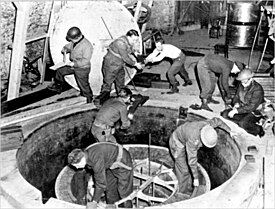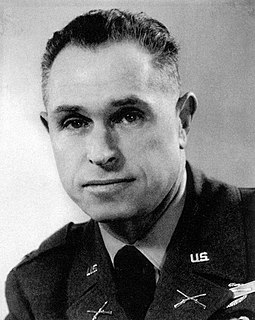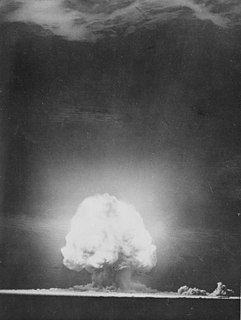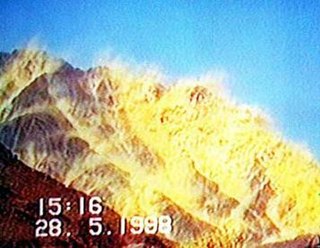This article needs additional citations for verification .(December 2017) |

Operation Harborage was an operation to capture German nuclear energy program scientists, materiel and facilities in southwestern Germany in the waning days of World War II.
This article needs additional citations for verification .(December 2017) |

Operation Harborage was an operation to capture German nuclear energy program scientists, materiel and facilities in southwestern Germany in the waning days of World War II.
Part of the Allied Alsos Mission, [1] Operation Harborage [note 1] was led by Manhattan Project intelligence division chief Col. John Lansdale, Jr. on behalf of project head General Leslie Groves, [2] under the direction of Alsos commander Col. Boris Pash. It was carried out by Alsos team members assisted by combat engineers from the 1269th Engineer Combat Battalion, the U.S. Sixth Army's T-Force intelligence assault force.[ citation needed ]
Shortly after the liberation of Paris it was decided to bomb German nuclear facilities wherever they lay in order to deprive the Soviet Union of their technology and personnel, unless American troops could get to them first. [2] In late April 1945 Harborage teams were directed toward the Black Forest cities of Hechingen, Bisingen and Haigerloch. These centers of the relocated German effort were all scheduled to be seized by the French and occupied by them post-war.[ citation needed ]
By cutting ahead of the French First Army's forward troops and operating behind enemy lines American technical intelligence units swept the area clean, seizing and transporting off what they could and destroying the rest. [note 2] The result left the French deprived of a share of the boost German technology and brainpower provided other Allies through the Cold War; these ended up divided among the U.S. (which reaped the lion's share), Soviet Union, and Britain.[ citation needed ]
Footnotes

The Pakistan Armed Forcesalso known asPak Armed Forces, are the combined military forces of Pakistan. It is the world's sixth-largest military measured by active military personnel and consist of three formally uniformed services—the Army, Navy, and the Air Force, which are backed by various constitutionally−sanctioned paramilitary forces. According to Global Firepower, the Pakistan Armed Forces are ranked as the 9th most powerful military in the world. A critical component to the armed forces' structure is the Strategic Plans Division Force, which is responsible for the maintenance and safeguarding of Pakistan's tactical and strategic nuclear weapons stockpile and assets.The President of Pakistan is the Commander-in-Chief of the Pakistan Armed Forces and the chain of command is organized under the Chairman of the Joint Chiefs of Staff Committee (JCSC) alongside the respective Chiefs of staffs of the Army, Navy, and Air Force. All branches are systemically coordinated during joint operations and missions under the Joint Staff Headquarters (JSHQ).

Aaron Bank was a United States Army colonel who founded the US Army Special Forces, commonly known as the "Green Berets". He is also known for his exploits as an OSS officer during World War II, when he parachuted into France to coordinate the French Resistance and organizing an operation intended to capture Adolf Hitler. In retirement, Bank warned about terrorism and modern technology. He is largely responsible for the high level of security at U.S. nuclear power plants since the early 1970s.

Technology played a significant role in World War II. Some of the technologies used during the war were developed during the interwar years of the 1920s and 1930s, much was developed in response to needs and lessons learned during the war, while others were beginning to be developed as the war ended. Many wars had major effects on the technologies that we use in our daily lives. However, compared to previous wars, World War II had the greatest effect on the technology and devices that are used today. Technology also played a greater role in the conduct of World War II than in any other war in history, and had a critical role in its outcome.

The Alsos Mission was an organized effort by a team of British and United States military, scientific, and intelligence personnel to discover enemy scientific developments during World War II. Its chief focus was on the German nuclear energy project, but it also investigated chemical and biological weapons and the means to deliver them.

Operation Big was an operation of the Alsos Mission, the Allied seizure of facilities, materiel, and personnel related to the German nuclear weapon project during World War II. It was tasked with sweeping several targeted towns in the area of southwest Germany designated to the French First Army, including Hechingen, Bisingen, Haigerloch, and Tailfingen.

Kirtland Air Force Base is a United States Air Force base located in the southeast quadrant of the Albuquerque, New Mexico urban area, adjacent to the Albuquerque International Sunport. The base was named for the early Army aviator Col. Roy C. Kirtland. The military and the international airport share the same runways, making ABQ a joint civil-military airport.

The Quebec Agreement was a secret agreement between the United Kingdom and the United States outlining the terms for the coordinated development of the science and engineering related to nuclear energy and specifically nuclear weapons. It was signed by Winston Churchill and Franklin D. Roosevelt on 19 August 1943, during World War II, at the First Quebec Conference in Quebec City, Quebec, Canada.

Hechingen is a town in central Baden-Württemberg, Germany. It is situated about 60 kilometres (37 mi) south of the state capital of Stuttgart and 90 kilometres (56 mi) north of Lake Constance and the Swiss border.
The Allies of World War II cooperated extensively in the development and manufacture of new and existing technologies to support military operations and intelligence gathering during the Second World War. There are various ways in which the allies cooperated, including the American Lend-Lease scheme and hybrid weapons such as the Sherman Firefly as well as the British Tube Alloys nuclear weapons research project which was absorbed into the American-led Manhattan Project. Several technologies invented in Britain proved critical to the military and were widely manufactured by the Allies during the Second World War.

The Soviet Alsos or Russian Alsos is the western codename for an operation that took place during 1945–1946 in Germany, Austria, and Czechoslovakia, in order to exploit German atomic related facilities, intellectual materials, material resources, and scientific personnel for the benefit of the Soviet atomic bomb project.
The industrial firm Auergesellschaft was founded in 1892 with headquarters in Berlin. Up to the end of World War II, Auergesellschaft had manufacturing and research activities in the areas of gas mantles, luminescence, rare earths, radioactivity, and uranium and thorium compounds. In 1934, the corporation was acquired by the German corporation Degussa. In 1939, their Oranienburg plant began the development of industrial-scale, high-purity uranium oxide production. Special Soviet search teams, at the close of World War II, sent Auergesellschaft equipment, material, and staff to the Soviet Union for use in their nuclear weapon project. In 1958 Auergesellschaft merged with the Mine Safety Appliances Corporation, a multinational US corporation. Auergesellschaft became a limited corporation in 1960.

Robert Ralph Furman was a civil engineer who during World War II was the chief of foreign intelligence for the Manhattan Engineer District directing espionage against the German nuclear energy project. He participated in the Alsos Mission, which conducted a series of operations with the intent to place all uranium in Europe into Allied hands, and at the end of the war rounded up German atomic scientists to keep them out of the Soviet Union. He personally escorted half of the uranium-235 necessary for the Little Boy atomic bomb to the Pacific island of Tinian. He was also a key figure overseeing the construction of The Pentagon building. After the war he founded Furman Builders Inc., a construction company that built hundreds of structures, including the Potomac Mills shopping mall in Woodbridge, Virginia.

T-Force was the operational arm of a joint US Army–British Army mission to secure German scientific and industrial technology before it could be destroyed by retreating German forces or looters during the final stages of the Second World War and its aftermath. Key personnel were also to be seized and targets of opportunity exploited when encountered. The effort was a business and technology-oriented parallel of sorts to the Monuments Men pursuit of art and financial treasure.
Technical Intelligence (TECHINT) is intelligence about weapons and equipment used by the armed forces of foreign nations. The related term, scientific and technical intelligence, addresses information collected or analyzed about the broad range of foreign science, technology, and weapon systems.

Project-706, also known as Project-786 was the codename of a research and development program to develop Pakistan's first nuclear weapons. The program was initiated by Prime Minister Zulfiqar Ali Bhutto in 1974 in response to the Indian nuclear tests conducted in May 1974. During the course of this program, Pakistani nuclear scientists and engineers developed the requisite nuclear infrastructure and gained expertise in the extraction, refining, processing and handling of fissile material with the ultimate goal of designing a nuclear device. These objectives were achieved by the early 1980s with the first successful cold test of a Pakistani nuclear device in 1983. The two institutions responsible for the execution of the program were the Pakistan Atomic Energy Commission and the Kahuta Research Laboratories, led by Munir Ahmed Khan and Abdul Qadeer Khan respectively. In 1976 an organization called Special Development Works (SDW) was created within the Pakistan Army, directly under the Chief of the Army Staff (Pakistan) (COAS). This organization worked closely with PAEC and KRL to secretly prepare the nuclear test sites in Baluchistan and other required civil infrastructure.

The National Air and Space Intelligence Center (NASIC) is the United States Air Force unit for analyzing military intelligence on foreign air and space forces, weapons, and systems. NASIC assessments of aerospace performance characteristics, capabilities, and vulnerabilities are used to shape national security and defense policies and supports weapons treaty negotiations and verification.

John Lansdale Jr. was a United States Army colonel who was in charge of intelligence and security for the Manhattan Project.

An air force – in the broadest sense – is the national military branch that primarily conducts aerial warfare. More specifically, it is the branch of a nation's armed services that is responsible for aerial warfare as distinct from an army or navy. Typically, air forces are responsible for gaining control of the air, carrying out strategic and tactical bombing missions, and providing support to land and naval forces often in the form of aerial reconnaissance and close air support.

The 1269th Engineer Combat Battalion was an engineer combat battalion that served in the United States Army in the European Theater of Operations during World War II. It saw action in France and Germany, serving notably with the Army's T-Force intelligence assault force in the capture of German atomic weapons facilities and personnel as part of Operation Big.